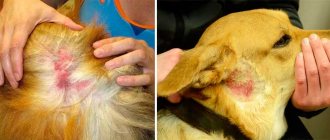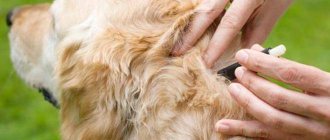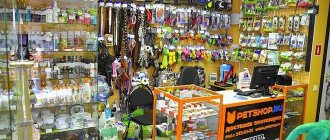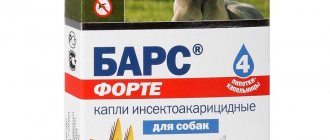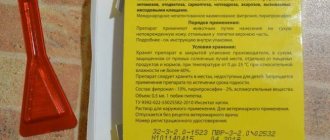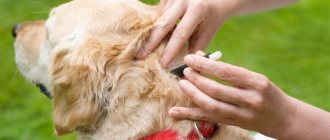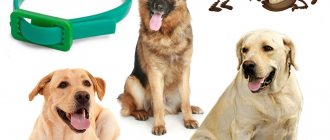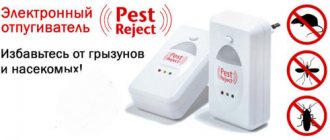A dog tick collar is one of the most used means of protecting pets. What should you consider when choosing? What is the principle of their operation? Let's consider a comparative analysis of the TOP 5 best.
The following types of tick protection for dogs are currently used:
- Drops on the withers against ticks;
- Anti-tick sprays and aerosols;
- Flea and tick tablets;
- Collars, leashes, keychains against ticks and fleas;
- Vaccinations.
If previously it was enough to use only one means of protection, now several are needed, combining drugs of different groups and compositions. One of them is a tick collar for dogs.
How to choose a safe and effective anti-tick collar for dogs, what are the features of its use, advantages and disadvantages? Read in this material.
Why do dogs need flea protection?
Fleas, ticks and other parasites pose a real threat to the health of the dog, as well as its owner. They cause discomfort and can cause infection with dangerous diseases. Substances released by parasites when they bite can cause an allergic reaction. Long-term flea parasitism leads to hair loss, disturbs the pet and deprives it of normal sleep. When bitten by fleas, dogs scratch the affected areas, introducing infection into the scratches. In addition, fleas are carriers of helminths, which parasitize the dog’s intestines and release toxic substances. Fortunately, there are many insect repellent products available today. One of them is a flea and tick dog collar.
Purpose and risk factors
Anti-tick collars for dogs are used to prevent acarosis caused by bites from almost 20 species of ticks, and entomosis caused by fleas.
The use of dog collars reduces the risk of babesiosis, Lyme disease, borreliosis, ehrlichiosis and anaplasmosis due to ectoparasite bites.
The danger of a dog being bitten by ticks and other ectoparasites
About the varieties of ticks, habitats and features of their development in a separate material on the site.
How does a flea collar work?
The collar is a strap or ribbon made of a flexible but durable material with a microporous structure. During the production process, the tape is impregnated with active substances, the required piece is cut off, supplemented with a fixative and hermetically packaged. The tightness of the packaging is a very important requirement. The collar starts working the minute you open the package. The product is attached to the dog’s neck, but the active substances it releases are gradually distributed throughout the body. Thanks to the micropores in the polymer tape, this process is quite lengthy. By selecting various materials it can be extended over several months.
The ingredients contained in the collar are designed to destroy and/or repel blood-sucking parasites, and/or disrupt the development of larvae. The active substances can be different, depending on them the effect of the collar is determined (insecticidal, acaricidal, ovicidal or repellent).
Please note that you should not expect instant results. A high degree of protection is achieved within a few days. During this time, the active substances are released from the collar and penetrate into the fatty secretion of the coat and the sebaceous glands of the skin. If the collar has expired, it must be replaced with a new one, otherwise it loses its meaning.
Precautions and side effects
The collar is purchased as long-term protection in the hope that the parasite will not be able to reach the dog during the active season. And during this time the owners relax, completely forgetting about fleas and other troubles of this kind. This cannot be done, for example, during a trip to the sea, the protection may be washed off by water, and the dog will collect ticks by running through the coastal bushes. Before your trip, it is better to take extra repellent with you and treat your dog after bathing.
There are times when a particular drug is not suitable for a dog. As a result, the dog scratches its skin and an allergy appears. You need to monitor the redness and condition of the fur, and contact a specialist in time if something goes wrong.
Sometimes vigilant owners go overboard with flea protection by adding drops to the chemical collar. In this case, an overdose may occur, which will lead to poisoning of the dog. Main symptoms: increased salivation, trembling, watery eyes, vomiting.
It is not recommended to use for animals that have suffered from illness, for elderly and weakened pets.
Types of flea collars
In fact, collars can act not only on fleas, but also on lice, lice, ticks and other external parasites. All existing flea collars for dogs can be divided into 3 large categories: destructive, repellent, ultrasonic.
Insectoacaricidal (destroying)
These collars are most effective because their action is aimed at destroying parasites. The active substances kill adults and may interfere with the growth of larvae. The validity period of the product depends on its type and is usually 2–7 months. To maintain effectiveness, the collar should not be removed from your pet, except when the animal needs to be washed. Sometimes, before the first use, it is necessary to stretch the collar a little to activate the substances (the need for this action should be indicated in the instructions).
Repellent (scaring)
Their task is to repel fleas and other blood-sucking insects. The main active substances are usually essential oils and extracts. They have a higher safety profile, but their effectiveness is lower than that of insecticides. As a rule, biocollars are used in conjunction with other, more effective means.
Most collars are universal: they are suitable for both adult dogs and puppies. Some manufacturers are developing products for children and for dogs of small and large breeds. Generally, flea collars of any type are not recommended for puppies under 2 months of age.
Ultrasonic
Theoretically, they produce high-frequency sounds that repel arthropods. The effectiveness of such devices has not been confirmed.
How to use a collar correctly
To avoid the development of dermatitis and uneven distribution of the composition, it is necessary to position the tape correctly. The owner must put the collar on the dog in such a way that there is a gap of 1.5 cm between the neck and the strap. After adjustment, the unnecessary end is cut off.
If your dog is infested with fleas, you should not apply the tape without first treating the fur. For this purpose, special flea shampoos are used.
Advantages and disadvantages
Anti-tick collars have their pros and cons. Disadvantages include:
- Ticks die only after being bitten. To solve this problem, manufacturers add special repellents to the chemical composition. This reduces the percentage of bites, but does not eliminate the risk completely. In addition, repellers quickly disappear. If insecticides are active for 3-5 months, then repellents are active for about one month. After they are completely exhausted, ticks and fleas will continue to die, but only after being bitten. Tick saliva contains pathogenic bacteria and microbes, as well as helminth eggs.
- The effectiveness of the collar is ensured by toxic chemicals. Manufacturers usually provide a detailed list of components without hiding anything from consumers. Some companies even write the name of the antidote in case of poisoning by harmful substances. Chemicals can cause allergic reactions, dermatitis, sneezing, salivation and lacrimation, and increased excitability. Thus, the instructions included with the tape require detailed study.
- A collar impregnated with a harmful substance requires long-term wear. It cannot be removed even at night. This means that not only dogs, but also owners inhale chemical vapors. Cats can become seriously poisoned by licking the protective tape. The same applies to small children. To avoid poisoning, you need to wash your hands after contact with the dog.
Some animals do not experience discomfort while wearing them, and the collar itself works for a long time and is effective. This doesn't mean this will happen to every dog.
Wearing an anti-tick collar has a number of advantages:
- Affordable price. Flea and tick drops are much more expensive. They are dripped monthly. The collar is purchased once every 3-5 months. Therefore, this remedy is much more economical.
- Easy to use.
- Hygiene. Drops are not absorbed immediately. If the owners do not want the dog to stain the furniture, they will have to keep it away from the sofas until the medicine is completely absorbed.
If owners follow the rules for using a collar, they have every chance to keep their dog safe.
How to figure out who is affected by a flea collar
Typically, the range of parasites that the collar is effective against is indicated on the packaging. It’s a little more difficult to understand the special terminology, but it’s also possible.
“Cidal” action implies the destruction of the parasite. Acaricides destroy ticks, insecticides destroy insects. Insectoacaricides – both. Inhibitors of chitin synthesis have ovo- and larvocidal effects. These are substances that disrupt the process of molting and oviposition in insects. Ovo is an egg, and larva is a larva. Such substances are relevant if the animal is infected with fleas, lice or lice, because eggs are more difficult to destroy than adults. Repellents are substances whose odor repels arthropods. They can be either natural (essential oils) or synthetic (“DEET”, etc.). Multi-component collars often contain insectoacaricides, ovicides, and repellents.
Why are fleas and ticks dangerous?
The very first danger is that these small creatures bite painfully, which causes considerable discomfort to the dog or cat. And it doesn’t matter what breed the animal is, a flea or tick can bite any of them. As for the second, its harm, of course, is not so great, but it causes skin irritation in the pet.
Insects can cause serious trouble for an animal.
Another very dangerous thing is that parasite bites can cause large blood loss. This can cause anemia (anemia). Such cases happen rarely, but you should not ignore them, because animals with weak immunity can become quite easy prey. For example, a small puppy or cat may simply not be able to cope with them on their own.
Pros and cons of safety collars
If you follow the instructions and recommendations of a specialist, a flea collar for a dog will become a reliable barrier against blood-sucking insects and ticks. This tool has a number of advantages:
- Ease of use;
- variety of choice (to determine the appropriate collar in each case);
- high safety profile (the collar is securely fixed to reduce the risk of it being removed, biting, or licking chemicals);
- duration of action;
- reasonable price.
Often, a collar looks like a more convenient means than drops and sprays, however, it also has its drawbacks:
- the product requires getting used to, the dog may be against another strap around the neck;
- insecticides and repellents may cause allergic reactions;
- the smell of essential oils may seem too intense;
- Since the substances are concentrated in the plastic tape and not on the skin, they take time to become active. So collars are not the best choice for instantly getting rid of fleas.
Advantages and disadvantages of using collars
The advantages of wearing anti-flea and anti-tick collars include:
- their long validity period is 5-7 months, with constant wearing;
- simplicity and ease of use;
- safety, because the active substance does not enter the animal’s bloodstream, penetrating only into the skin.
The disadvantages include:
- it is not possible to provide control over the interaction of the active substance and the dog’s skin and coat, which does not guarantee constant protection;
- The long period of action of the tick collar declared by the manufacturer often reduces the attention of owners to protection issues, creating only the illusion of protection;
- the dog may experience discomfort from wearing a collar, especially at first and/or when it is rarely used;
- the collar often causes an allergic reaction, it is necessary to monitor your health condition, if necessary, stop using it and consult a doctor;
- there is a possibility of overdose of insectoacaricides when used together with drops on the withers or sprays;
- high cost of well-proven foreign-made collars.
Tick bite on a dog and comparative size of the tick after the bite
Rules of application
Despite their popularity and high degree of safety, dog collars are used strictly according to the instructions. It must be remembered that improper use of the product can cause a lot of inconvenience to the animal.
- The collar is fixed on the dog in such a way that there is a gap of 1–1.5 cm (an average finger thickness) between it and the neck. The strap should not dangle or fit too tightly.
- Each dog has its own type of collar. This takes into account her weight, neck size, and health indicators. Collars are not recommended for small puppies for safety reasons.
- The collar must be replaced with a new one immediately after its service life expires. Typically, such products do not last more than 4-6 months, but the specific period is always indicated in the instructions.
- You cannot use a collar and apply other anti-flea products on the same day, as this can lead to poisoning of the animal.
- It is best to buy a flea collar for your dog at a large pet store or veterinary pharmacy, so you can be sure of its quality.
Question answer
When an owner chooses parasite protection for his pet, he is faced with many questions:
- Which collar is best for small breeds? You need to choose flea tape according to the size of the animal, while maintaining the required concentration of toxic substances. The strap should not squeeze your neck or dangle around it.
- At what age can puppies wear a protective accessory? Since small animals are vulnerable to the effects of poisons, it is recommended that a flea collar be used on puppies from 4 weeks of age.
- How long does the active flea agent last on the strap? The duration of action of toxins impregnating the straps depends on the manufacturer, as well as on the individual characteristics of the animal. Most often, the effectiveness of protective tapes lasts from 2 to 7 months.
Whatever flea collar you choose for your dog, you must first take into account the age, condition, and size of the animal.
A properly selected accessory can permanently rid your pet of intrusive parasites.
Precautionary measures
- Most collars (especially the insecticidal and insectoacaricidal groups) are contraindicated for pregnant and lactating females, sick and weakened dogs, and puppies. Collars with phytocomponents have fewer contraindications, but can cause an allergic reaction.
- During the first hours of wearing the collar, the dog should be under constant supervision. If your animal experiences any unpleasant symptoms (lacrimation, vomiting, fever, skin irritation, etc.), you should immediately remove the collar and consult a specialist.
- Do not store a flea collar (especially an opened package) near food, personal belongings, or in places accessible to children and animals.
- It is important to ensure that your four-legged pet does not try the collar on its teeth, as its active substances can cause disorders of the digestive and nervous systems.
Contraindications and restrictions
Insectoacaricidal collars, in terms of the degree of impact on the body, are classified as “moderately dangerous substances” (hazard class 3 according to GOST 12.1.007-76), and do not have a resorptive-toxic or locally irritating effect. The active substances contained in the composition are toxic to bees, as well as fish and other aquatic organisms and belong to “hazardous substances” (hazard class 2).
For safe use, the following points should be considered:
- collars are not used for pregnant dogs, especially in the last third of pregnancy and lactating females, patients with infectious diseases and convalescent animals;
- anti-tick collars are used for dogs older than 8-12 weeks of age, depending on the manufacturer;
- Cat collars should not be used on dogs.
Side effects are observed in rare cases, with increased individual sensitivity of the animal to the active ingredients, individual reactions are possible (excessive salivation, lacrimation, muscle tremors, vomiting, skin irritation).
Allergic reactions may occur - itching and signs of skin irritation in the neck area. In such cases, stop using the collar and consult a doctor for advice.
Symptoms of overdose in dogs are observed when used together with other drugs.
Recommended Collars
BARS®.
The insecticidal collar is used to protect against fleas, ixodid ticks, lice, and lice. The polymer tape can be 80 cm long (for large dogs), 50 cm (for medium dogs) and 35 cm (for small dogs). The collar contains fipronil and diflubenzuron. The insect growth regulator (diflubenzuron) suppresses the growth of integumentary tissues of parasites, disrupts the development of larvae in eggs and molting, and prevents pupae from fully developing. Fipronil is an insectoacaricide. It is not absorbed into the systemic circulation. Its accumulation occurs in the epidermis, hair follicles and sebaceous glands. With the secretion of the sebaceous glands, the substances are distributed over the surface of the skin and provide a long-lasting protective effect. The period of use of the BARS® collar is up to 4 months. It is not recommended to use the collar for puppies under 2 months of age, sick and weakened animals, pregnant (in the last third of the term) and lactating females.
FitoDoc®
. The repellent collar is designed to repel ixodid ticks, fleas, and other insects. It comes in 3 sizes: 80 cm (for large breed dogs), 50 cm (for medium dogs) and 35 cm (for small dogs). The collar contains natural ingredients: essential oils of margosa, citronella, eucalyptus, tea tree, lavender. They also accumulate on the epidermis, hair follicles and sebaceous glands of the animal's body and provide a repellent effect. The FitoDoc® collar provides protection for 3 months against fleas and other insects and up to 5 weeks against ticks. The product should not be used on puppies under 2 months of age.
4 with a ponytail®
. This collar is designed to repel fleas, lice, lice, scabies and ixodid mites. It contains essential oils of citronella, lavender, geranium, peppermint, eucalyptus. Active substances accumulate in the sebaceous glands and have a detrimental effect on insects. The collars are available in three sizes: 35, 50 and 65 cm. The product has a high safety profile and is usually well tolerated by dogs of different ages and breeds, including sick and weakened animals, pregnant and lactating females. It should not be used only for puppies younger than 2 months and with individual intolerance to the active substances. When worn continuously, the collar provides protection against insects for up to 3 months and against ticks for 4 weeks.
Which brand of anti-tick collar for dogs is better to choose?
The rating is based on collars for both large dogs and medium and small breeds. Prices range from 160 to 2000 rubles, so you can find an option suitable for any budget.
The TOP includes the following manufacturers that produce the best anti-tick collars for dogs:
- Agrovetzaschita (AVZ) is a Russian company that produces more than 380 units of products not only for pets, but also for productive animals, fish, reptiles and birds. The company was founded in 1993, and in 2022 AVZ exports more than 330 products to 19 countries.
- Bayer is an international company with experience in healthcare and agriculture. It was founded in 1863 in Germany by Friedrich Bayer and Joann Friedrich Wescott. In Russia, there is an animal health department called Animal Health, which develops high-quality veterinary products. The company produces tick collars in different price categories.
- Biogard is a Russian company founded in 2000. Cooperation with the Swiss company Swiss Laboratory Defense made it possible to develop high-tech products for animals under the Mr. Bruno brand. It offers a wide range, including anti-tick collars, suitable for sick and weakened animals.
- Beaphar is an international company founded in 1939 in the Netherlands. The company produces high-quality products for caring for pets and maintaining their health, including collars. The plant operates in accordance with GMP standards, according to which general production and laboratory testing parameters are regulated and evaluated.
The best electric collars for dogs
Popular brands of protective accessories
Due to the fact that pet stores and veterinary pharmacies offer a wide selection of collars for eliminating fleas and ticks on dogs, many may have some difficulty choosing one. For this reason, it is worth carefully considering popular product brands and their important features.
When choosing dog collars to eliminate parasites, you need to pay attention to two important requirements - high efficiency and safety. Products with good effects can rid your pet of bloodsuckers in a matter of hours.
Beaphar
Beafar products are very popular, this is due to their high quality and good efficiency. Anti-flea collars for dogs are also quite in demand, this is explained by the following positive nuances:
- convenient use;
- high concentration of active substance that eliminates fleas, ticks, lice and other parasites;
- When wearing a collar, dogs do not experience any unpleasant sensations, pain, or discomfort;
- affordable price.
However, the products of this company have negative qualities:
- the full effect of the collar is observed only after 5 days;
- the validity period is not long - from 2 to 5 months;
- The products have some contraindications - should not be used for puppies under 6 months old, not used for pregnant and lactating bitches, or for sick animals.
Foresto
The flea collar from Foresta is one of the best products of this type. It will be able to protect your pet from harmful parasites for a long period.
This tool also has a number of important features:
- produced in two types - for dogs weighing up to 8 kilograms and animals over 8 kilograms;
- Additionally, along with the collar there are special clips that have a reflective effect in the dark. With the help of these elements it will be possible to see where the animal is at night;
- The main advantage of Foresto collars is their versatility. They allow you to eliminate not only fleas and ticks, but also lice, lice and other parasites;
- Insecticides can be used for dogs older than 7 months.
Kiltix
Kiltix Collar is the best insecticide in its category that helps eliminate ticks, fleas and other blood suckers on dogs. It is highly popular among many dog owners.
It is worth noting! The effect of the headband does not occur immediately, but only a day after putting it on the animal. The effect of the product lasts for a long period – 6-7 months.
Kiltix collars are not suitable for puppies. These products are best used for adult dogs that arrive in excellent physical shape. It is also worth considering that this insecticidal agent should not be used on pregnant or lactating bitches.
Hartz UltraGuard Flea & Tick Collar
An excellent and optimal option for eliminating fleas and ticks on dogs would be Hartz collars. Moreover, they have good qualities:
- high efficiency. Elimination of pathogenic insects occurs within a few hours after putting on the headband;
- collars can be used for adult dogs and small puppies;
- long term protection against parasites. After putting on the product, the protective effect will be observed for 7 months;
- does not have a toxic effect on the animal;
- has a pleasant smell;
- Hartz collars are not very expensive;
- When wearing the product, dogs do not experience any unpleasant symptoms or allergies.
Leopard
The Bars company is a well-known company that produces a variety of insecticidal products for dogs and cats. Among the products, drops, tablets and, of course, collars are especially popular. The latter provide long-term protection against bloodsuckers.
The leopard flea collar for dogs has several important features:
- There are several versions of the rim on sale, which can have different sizes. Each type is designed for small, medium and large dogs;
- You should not use a collar on puppies that are not yet two months old;
- The effect of the product does not occur immediately, but after 24 hours;
- The duration of protection is not very long - from 2 to 5 months.
Note! The collar should not be used on pregnant or lactating bitches, otherwise serious health problems may arise. Before using an insecticide, you should carefully study its instructions.
